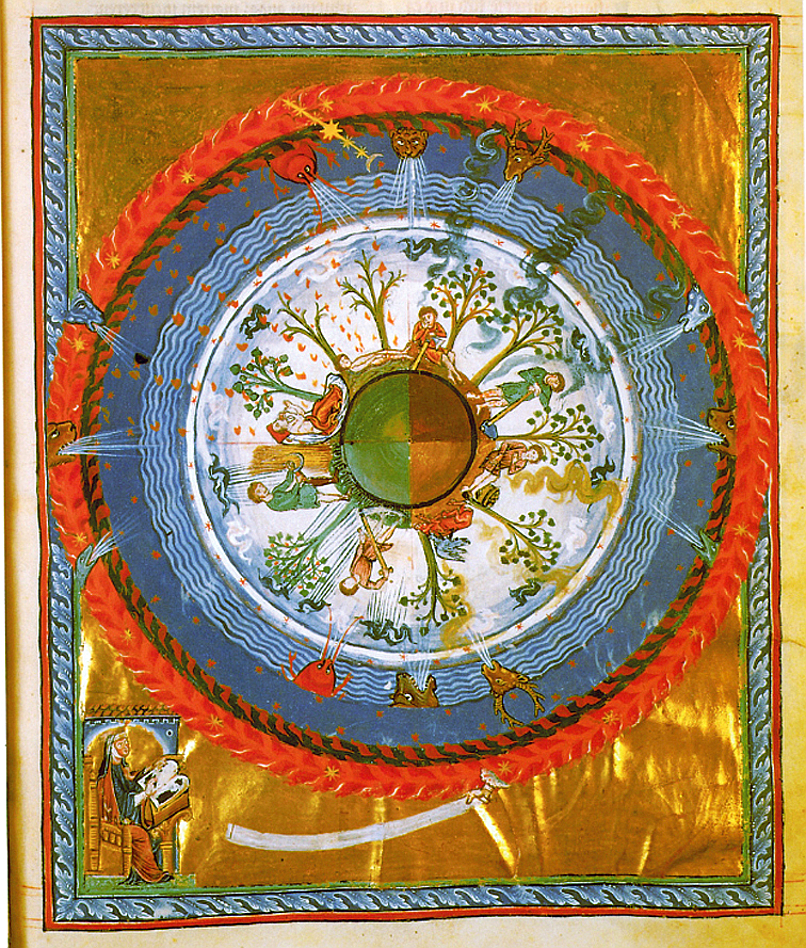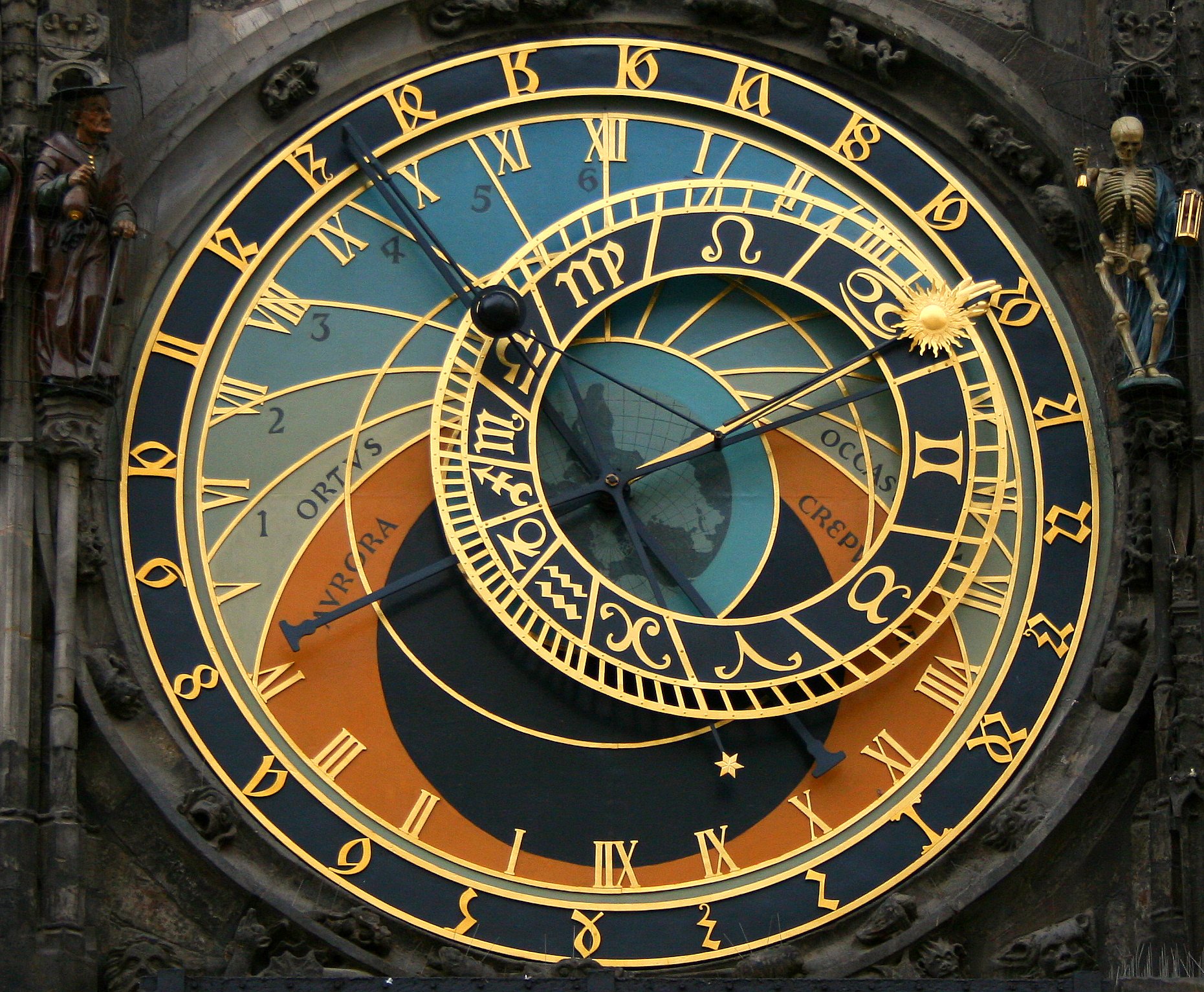.JPG) |
Construction on Pisa Cathedral was started in the 11th century
the bell tower was begun in the 12th; it started leaning almost at once |
It’s hard to say
when the Dark Ages ended and the Middle Ages began. Some people even argue that
the Dark Ages and the Middle Ages were the same thing. After all, they were both Dark weren’t
they? Of course, if the Middle Ages and the Dark Ages were the same thing, then part of the Renaissance occurred in the Dark Ages...
Probably one of
the biggest misconceptions about the Middle Ages is that people never washed.
They might have a bath once a year at the most…oh, and they believed the earth
was flat.
 |
Medieval illustration of a spherical earth from
the 12th century book, Liber Divinorum Operum
by Hildegard of Bingen
|
In fact, bath
houses were a common sight in the Middle Ages. The Romans had put them in and
really, they never went out of fashion. There are even records of people taking
baths once a week. It was considered good manners to wash your hands before and
after dinner (and you couldn’t rest your elbows on the table). There was even communal
bathing where lords and ladies ate their dinner while sitting in a bath…somehow,
I’d rather not revive that fashion.
And as for the
earth being flat…well, that went out of fashion during the Greeks and it was
never seriously considered since. There are Medieval depictions of a round
earth and most scholars even had a general idea how far it was in circumference.
The only reason we were told they thought it was flat, was because Washington Irving took
some liberties in a history of Christopher Columbus.
 |
| Roadside picnic? Possibly 12th century |
As far as I can tell, the Middle Ages weren't dark and dreary. There was a host of musical instruments, many the precursors to instruments we are familiar with today. Not all songs were written for the Church, like
Sumer Is Icumen In which is about summer time. The modern depictions of peasants wearing un-hemmed gunny sacks (who wouldn't hem their gunny sack?!) don't match any of the illuminations from the time. Bright colors were in during the Middle Ages and though the common peasants probably couldn't afford the rich dye the nobles could, many less brilliant colors can be produced with moss, berries or other homegrown plants. Modern forensic evidence also reveals that cathedrals would have been a brilliant riot of colors inside and out...no drab gray stone, there.
 |
13th century ivory statue of Mary
and Jesus, made in France |
Women weren't repressed
during the Middle Ages, either. It’s true that they were used as political
footballs, but so were the men. There are several accounts of powerful ladies
kidnapping perspective husbands and forcing them into marriage. Robert the
Bruce’s mother found this method particularly Useful. Women had trades and
ambitions just like men. Abbess Hildegard of Bingen was a polymath who wrote a
book on medicine and was so respected that Popes and Kings asked for her advice (a
polymath is a genius in multiple areas; Leonardo Da Vinci was one). A woman even wrote the first
autobiography in the English language. Her name was Margery Kempe.
 |
This interesting Medieval painting
shows a woman riding astride in a skirt
clearly doing some damage with a sword |
There were
advancements in Science, as well. A friar named Roger Bacon shined light through
a sphere of water and discovered that white light is made up of colours. Sorry
Isaac Newton. Inspired by the story of
Daedalus, A monk named Eilmer of Malmesbury made an attempt at gliding
flight in the 11
th century. He soared a little ways before he fell and
broke his legs. He was forbidden from trying again even though he’d figured out
that he’d need a tail to stabilize himself.
There are accounts
of sailors using compasses as early as the beginning of 13
th century (through the
Vikings probably had compasses when they sailed to the New
World in the Dark Ages) and glass reading stones used for magnifying text. An
abbot named Richard of Wallingford made an astronomical clock in the 14
th
century. Before that, everyone used water clocks; they were useful for telling
time…and putting out occasional fires.
 |
Installed in 1410, the Prague Astronomical Clock
is the oldest working Astronomical Clock in the world |
 |
| Hours of Jeanne d'Evreux c. 1325-1328 |
Even Medieval
medicine was surprisingly complex. They knew how to tie off arteries and insert
drains in wounds and even had a rudimentary understanding of herbs and plants
that would slow infection. And hospitals weren't uncommon, especially in the 13th century. Of course, the Black Death swept through Europe in
the 1300s, but it only arrived after it had finished with Asia. In fact, in the first half of the Middle Ages, people
were about the same height as they are today, which means that they had good diets and were generally healthy.
 |
Canterbury Cathedral, an early example of Gothic
architecture, was built in the 11th century
and figured into Chaucer's Canterbury Tales |
The Middle Ages, of course, were the days of feudalism, where lords owned vast tracts of land, while peasants had to rent, and serfs were practically slaves. But, the roots of the middle class lie in Medieval society, only they were called the freeholders in those days. The Yoemen, for example, owned land,
not less than one hundred acres, and were sometimes more wealthy than the
gentry. The serfs
were at the dead bottom and required to work for their lords
in return for justice and the ability to work land for themselves…but to tell
the truth, serfs
were required to work for fewer days in a year than modern full-time
employees.
 |
European Beaker from the 13th century
Corning glass museum |
Now, did the Catholic Church
stifle learning? If you look above, you’ll see that the scientists that I’ve
mentioned were all friars, monks or abbots…and they weren’t the only ones. The Catholic Church might have coloured the facts or reinterpreted them to suit it, but it also
didn’t keep the Bible to itself, either. Before the advent of the printing
press (which was invented in the Middle Ages) Bibles were copied by hand so
meticulously that if there was one typo, the whole page was destroyed and
started over (I’d better stop what I’m writing right now). Bibles were clearly
very rare and expensive, but Henry the VIII still commanded that there be one
chained in building of his new Anglican Church (after he'd demolished a lot of them, but that's another story).
 |
The exquisite Gloster Candlestick
made in England c. 1104 -1113 |
To put it in a
nutshell, the Renaissance never happened for the simple reason that it didn’t
need to happen. The Middle Ages were doing very well on their own. They didn’t
need a rebirth; enlightenment had been around for years. Yes, there was flowering of the arts and science, but the flower could only bloom because the stem had been growing steadily all through the Dark Ages.
Advancement was slower than in earlier and later years, but when a gigantic empire collapses and no less than three powers attempt to take over the world (not to mention a plague that wiped out a third of the population) advancement gets put on the back burner. Learning was a small flame that continued to burn, it only needed economic stability to blow it into a bonfire.
~Psyche









Wow, just think, we could have had flight hundreds of years earlier if only that monk had disobeyed and continued his inventions in secret.
ReplyDeleteI love Hildegard von Bingen's music; I found out about it probably two years ago. It's beautiful.